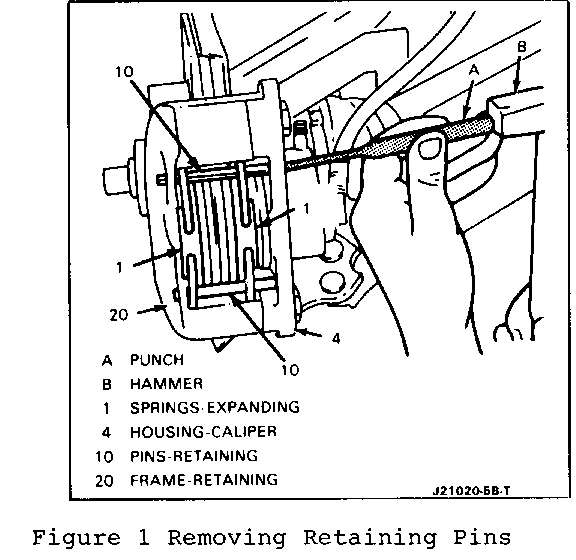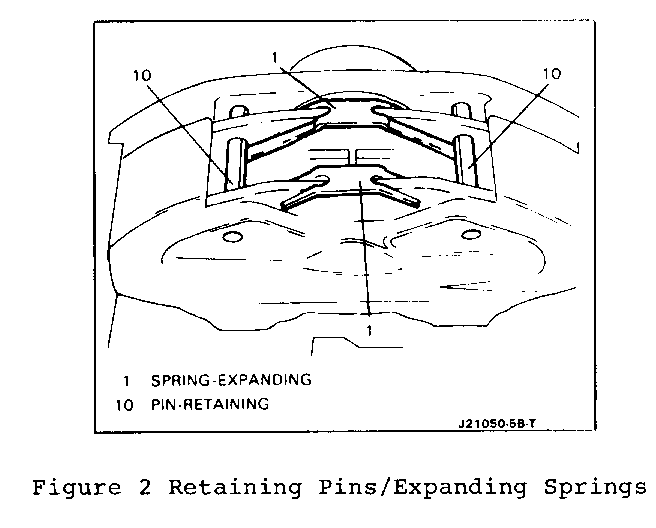SERVICE MANUAL UPDATE REVISED SHOE AND LINING

Models Affected: 1988-90 LEMANS
This bulletin cancels and supersedes the On-Vehicle Service "Shoe and Lining" removal and installation procedures found on page 5B-2 in the 1988, 1989 and 1990 Pontiac LeMans Service Manuals.
FRONT DISC BRAKE PADS
Figures 1 and 2
REMOVE OR DISCONNECT
Raise and suitably support vehicle. Refer to GENERAL INFORMATION (Section OA).
1. Front wheels. Refer to WHEELS AND TIRES (Section 3E).
IMPORTANT: ---------- Caliper removal is not required to replace the disc brake pads or to service the rotor.
2. Pad retaining pins from the inside using a hammer and punch. Drive from the inside-out (Figure 1).
3. Expanding springs from under retaining pins. The springs may pop off as the pins are removed.
CAUTION:
THE EXPANDING SPRINGS ARE HELD UNDER TENSION BY THE RETAINING PINS. EXERCISE CAUTION WHEN REMOVING RETAINING PINS, AS THEY COULD CAUSE PHYSICAL INJURY.
4. Pads from caliper.
A. Remove outer pad in a downward direction.
B. Compress the caliper piston with channel-lock pliers to remove inner pad.
INSTALL OR CONNECT
1. Pads into caliper with the metal wear sensor on the top of inboard pad.
*When installing pads, check that they can be moved slightly forward and backward in the caliper.
CAUTION:
THERE ARE THREE DISTINCT PADS INCLUDED WITH THE DISC BRAKE REPLACEMENT SET: THE LEFT INBOARD PAD, THE RIGHT INBOARD PAD, AND THE TWO OUTBOARD PADS. FAILURE TO ASSEMBLE THE PADS CORRECTLY - WITH THE WEAR SENSORS AT THE TOP OF THE RIGHT AND LEFT INBOARD PADS - WILL RESULT IN REDUCED BRAKING CAPABILITY, PRESENTING A SAFETY RISK TO THE VEHICLES DRIVER.
2. Upper retaining pin; drive in from the outside.
3. Expanding springs; hook long ends under retaining pins (Figure 2).
IMPORTANT:
The long side of the expanding springs must be positioned together, toward the inside (middle) of the caliper; with the short side of the springs to the inner and outer perimeters of the caliper. Failure to position these springs correctly will result in excessive brake noise and reduced braking capability (Figure 2).
4. Lower retaining pin; drive in from the outside. Be sure to hook the long side of the expanding spring under the pin.
5. Front wheels, Refer to WHEELS AND TIRES (Section 3E).
*Lower vehicle. Refer to GENERAL INFORMATION (Section OA)


General Motors bulletins are intended for use by professional technicians, not a "do-it-yourselfer". They are written to inform those technicians of conditions that may occur on some vehicles, or to provide information that could assist in the proper service of a vehicle. Properly trained technicians have the equipment, tools, safety instructions and know-how to do a job properly and safely. If a condition is described, do not assume that the bulletin applies to your vehicle, or that your vehicle will have that condition. See a General Motors dealer servicing your brand of General Motors vehicle for information on whether your vehicle may benefit from the information.
